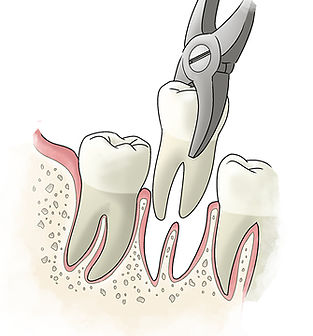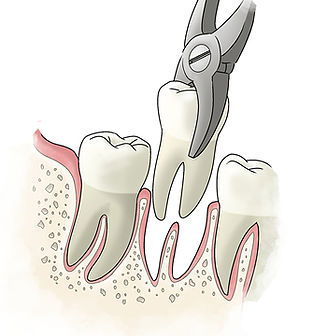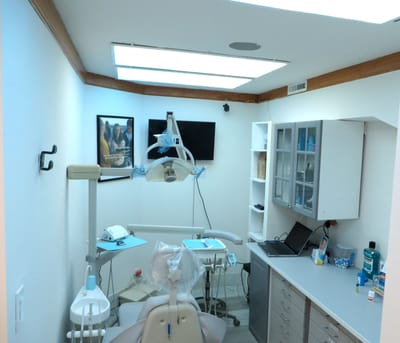Tooth Extraction Upper East Side
Tooth Extraction Upper East Side
 Tooth Extraction Upper East Side
Tooth Extraction Upper East SideWhen it comes to dental procedures, tooth extraction — or having teeth "pulled" — is among patients' most dreaded prospects. Also referred to as exodontia, tooth extraction involves removing a tooth from its socket in the jaw bone. Before our dentist considers extraction, every effort will be made to try to repair and restore your tooth. However, sometimes a tooth extraction is necessary.
Reasons for Tooth Extraction
Severe Tooth Damage/Trauma: Some teeth have such extensive decay and damage (broken or cracked) that repair is not possible. For example, teeth affected by advanced gum (periodontal) disease may need to be pulled. As gum disease worsens, the tooth — supported by less surrounding bone — often loosens to such an extent that tooth extraction is the only solution.
Malpositioned/Nonfunctioning Teeth: To avoid possible complications that may result in an eventual, negative impact on oral health, our dentist may recommend removing teeth that are malaligned and/or essentially useless (teeth that have no opposing teeth to bite against).
Orthodontic Treatment: Orthodontic treatment, such as braces, may require tooth extraction to make needed space for improved teeth alignment.
Extra Teeth: Also referred to as supernumerary teeth, extra teeth may block other teeth from erupting.
Radiation: Head and neck radiation therapy may require the extraction of teeth in the field of radiation in order to help avoid possible complications, such as infection.
Chemotherapy: Chemotherapy weakens the immune system, increasing the risk of tooth infections, heightening the risk of extraction.
Organ Transplant: Immunosuppressive medications prescribed after organ transplantation can increase the likelihood of tooth infection. As such, some teeth require removal prior to an organ transplant.
Commonly Extracted Teeth
Wisdom teeth removal is one of the more common categories of tooth extraction. Many dental professionals will recommend removing wisdom teeth (third molars) before they are fully developed — usually in the adolescent years — to help eliminate potential problems. One problem that could occur is development of an impacted tooth that has surfaced and has no room in the mouth to grow. Other problems associated with impacted teeth include infection, decay of adjacent teeth, bite interference and gum disease.
Extractions of some permanent teeth that have not erupted — such as the canines, which are also known as fangs or eye teeth — may be required in order to make space for orthodontic treatment.
Types of Tooth Extraction Upper East Side
Simple Tooth Extraction Upper East Side:
These are performed on teeth that are visible in the mouth. General dentists commonly do simple extractions, and most are usually done under a local anesthetic, with or without anti-anxiety medications or sedation.
Surgical Tooth Extraction Upper East Side:
These involve teeth that cannot easily be seen or reached in the mouth, either because they have broken off at the gum line or they have not fully erupted. Performed by dentists or oral surgeons, surgical extractions require some type of surgical procedure, such as bone removal, removing and/or lifting and folding back all or part of the gum tissue to expose the tooth, or breaking the tooth into pieces (called tooth sectioning). Surgical extractions can be done with local anesthesia and/or conscious sedation. Patients with special medical conditions and young children may receive general anesthesia.
Preparing for Your Tooth Extraction Upper East Side
Prior to a tooth extraction, our dentists or oral surgeon will discuss your medical and dental histories and take X-rays. Some dental professionals will prescribe antibiotics to be taken before and after surgery. Antibiotics are more likely to be given to patients with infection or weakened immune systems at the time of surgery, those undergoing longer surgeries, or young or elderly people.
To avoid possible complications, inform your dentist about all the medications — prescriptions, over-the-counter (OTC) and herbal — you are taking. For example, aspirin slows the blood-clotting process; gingko biloba and ginseng also affect clotting.
Many people like to be sedated for a tooth extraction. Possible sedation dentistry options include nitrous oxide ("laughing gas"), an oral sedative (such as a Valium pill) or an intravenous sedative that is administered into your veins by injection. If you opt for nitrous oxide, you can drive yourself home. If you choose one of the other types of sedation, you will need someone to drive you to and from your dental visit.
Extraction Post Op Instruction
What to Expect During a Tooth Extraction Upper East Side
At the extraction appointment, your dentist will numb, or anesthetize, the tooth to be extracted, as well as the jawbone and gums surrounding it. Typically, a local anesthetic such as novocaine or lidocaine is injected to eliminate discomfort.
Simple Tooth Extraction Upper East Side: Your dentist will grasp the tooth with specialized pliers called extraction forceps and move them back and forth to loosen the tooth before removing it. Sometimes, a surgical cutting instrument called a luxator — which fits between the tooth and the gum — is used to help loosen the tooth. Dentists also use "elevators," which are levers that look similar to small screwdrivers. Usually a dentist will first use an elevator to wedge between the tooth and the surrounding bone. The elevator places pressure on the tooth, which helps to expand the tooth's socket and separate its ligament.
Surgical Extractions: These procedures generally are more complicated, so your dentist may sedate you before numbing your tooth, then use a dental drill, apply pressure to your tooth with an elevator or extraction forceps, and remove your tooth. Greater surgical effort may be needed in other cases. For instance, gum and/or bone tissue may cover or surround a tooth in a way that makes it difficult for your dentist to view and/or access it. If so, your dentist will need to cut and lift back or remove this tissue. Sometimes a tooth is so firmly anchored in its socket that your dentist must cut the tooth into pieces in order to remove each portion individually.
Your dentist may need to place stitches and/or add bone (natural or synthetic) in the extraction site after the procedure. Some stitches are absorbable and will disintegrate on their own; others require removal by your dentist, usually about a week after the extraction.
Tooth Extraction Aftercare
Since bleeding is normal after an extraction, your dentist will have you bite on a piece of gauze for about 30 minutes to put pressure on the area and allow the blood to clot. Some swelling and discomfort are normal
after a tooth extraction.
Cold compresses or ice packs can help decrease the swelling. If your jaw is sore and stiff after the swelling dissipates, apply warm compresses. Sleeping with your head face upward to relieve pressure on the jaw, and keeping your head elevated with extra pillows also may help. In addition, your dentist may recommend you take an OTC pain reliever such as ibuprofen (Motrin or Advil) for several days. With surgical extractions — which generally cause more pain afterwards — your dentist may prescribe a prescription pain medication.
Tooth Extraction Upper East Side




